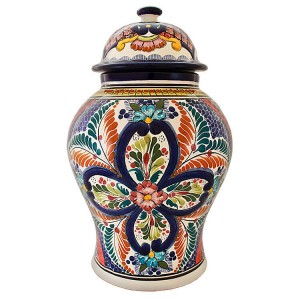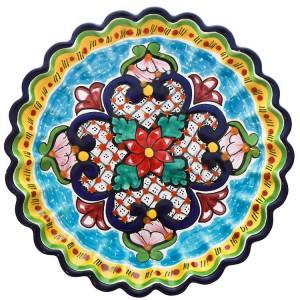Talavera is a term shrouded in mystery, though it is no less mysterious than the human persistence in shaping glazed and painted objects from the earth: objects which clink like muffled bells when struck together and allure us with their beauty. The ceramic ware known as Talavera is no doubt part of Mexico’s most important traditional art forms.
Historically, the art of Talavera is related to certain spaces: the kitchen, the church and convent, the facade and interior of the home—as well as the workshop, where the age-old rituals of the craft are still performed. Like sculpture, this art is spatial, and it also encompasses an internal space: that of the imagery represented on its surfaces. These spaces make up a world where reality and fantasy are one, where hands that make and buy and sell join with hands that paint the shape of the artisan’s. This is the world of Talavera: a world within our own world.
Among the first natural settings for Talavera is the typical kitchen featured in Puebla: where the tiles that cover the walls—sometimes even the ceiling—and the platters of food on their way to the table, combine to form a “culinary architecture” where the interior space of the kitchen becomes a full-scale reflection of those typical dishes from Puebla—richly flavored, colorful and unique. The tiled kitchen and the Talavera dinnerware made of glazed white ceramic become a sort of echo chamber where the food is enhanced by the visual condiment of Talavera. In addition to the one afforded by the meal then, Talavera offers a pleasure that enters through the eyes. And like food, it is a pleasure that is shared.
A very different kind of kitchen—the traditional pharmacy—was literally lined with Talavera containers which were not only practical but often strikingly handsome. These were impermeable on the inside and were often inscribed—before they were fired—with the name of the herb or substance they would contain. Or, if the jars had been commissioned to be used in the pharmacy of a particular convent, they would feature the emblem of that religious order.
Churches and convents, in fact, were also natural settings for Talavera. Both housed an incredible variety of objects like the lebrillo; which was used for the both the solemn rite of baptism, as well as the banal. Day-to-day washing of hands or feet. Both the sacred and profane gestures of a community are concentrated in the ‘Talavera of cimrlem and convents. Though modest, this glazed curibessume pourided a sort of vivid centerpiece to the shared life of the cloister. Outside, the facades of churches were tiled with Talavera in an attempt to make the exterior synonymous with the wealth of gold which their altars flaunted. These facades truly project the splendor of Talavera.
Article excerpt from Artes de Mexico Magazine – June 1992


